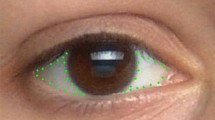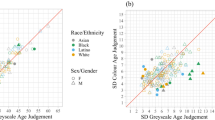Abstract
Facial contrast – the difference in coloration between facial features and the surrounding skin – is an important cue for several aspects of face perception, including the perception of age and sex. However, previous work showing age declines in facial contrast has investigated only female faces, and studies demonstrating sex differences in facial contrast have only used young adult faces as stimuli. In the present work we examined whether age related declines in facial contrast are similar in both female and male faces, and whether sex differences in facial contrast are similar across the adult lifespan. In a sample of 151 male and female faces, drawn from three age groups (young adult, middle-aged, older adult), we analyzed contrast around three facial features: eyebrows, eyes, and lips, in each of the three channels of CIEL*a*b* color space. We replicated the finding that feature contrasts decline with age in female faces, and found similar declines with age in facial contrast in male faces. We also found that the sex differences in luminance contrast around the facial features were present throughout the adult life span. Our findings demonstrate that age differences in facial contrast generalize to both sexes, and that sex differences in facial contrast generalize to all adult ages, indicating the general relevance of facial contrast cues. These findings also have implications for the understanding of facial beauty and of beautification practices such as makeup.



Similar content being viewed by others
References
Brainard, D. H. (2003). Color appearance and color difference specification. In S. K. Shevell (Ed.), The science of color (pp. 191–216). Oxford: Elsevier.
Burt, D. M., & Perrett, D. I. (1995). Perception of age in adult Caucasian male faces: computer graphic manipulation of shape and colour information. Proceedings of the Royal Society of London, 259, 137–143.
Ebner, N. C., Riediger, M., & Lindenberger, U. (2010). FACES–A database of facial expressions in young, middle-aged, and older women and men: development and validation. Behavior Research Methods, 42, 351–362.
Etcoff, N. L., Stock, S., Haley, L. E., Vickery, S. A., & House, D. M. (2011). Cosmetics as a feature fo the extended human phenotype: modulation of the perception of biologically important facial signals. PloS One, 6(10), e25656. doi:10.1371/journal.pone.0025656.
Farkas, L. G., & Munro, I. R. (Eds.). (1987). Anthropometric facial proportions in medicine. Springfield: Charles C Thomas.
Fink, B., Grammer, K., & Thornhill, R. (2001). Human (Homo sapiens) facial attractiveness in relation to skin texture and color. Journal of Comparative Psychology, 115(1), 92–99.
Frost, P. (2005). Fair women, dark men. Christchurch: Cybereditions.
George, P. A., & Hole, G. J. (1995). Factors influencing the accuracy of age estimates of unfamiliar faces. Perception, 24(9), 1059–1073.
Graham, J. A., & Jouhar, A. J. (1981). The effects of cosmetics on person perception. International Journal of Cosmetic Science, 3, 199–210.
Gründl, M., Knoll, S., Eisenmann-Klein, M., & Prantl, L. (2012). The blue-eyes stereotype: do eye color, pupil diameter, and scleral color affect attractiveness? Aesthetic Plastic Surgery, 36, 234–240.
Hill, H., Bruce, V., & Akamatsu, S. (1995). Perceiving the sex and race of faces: the role of shape and colour. Proceedings of the Royal Society of London B, 261, 367–373.
Huguet, P., Croizet, J.-C., & Richetin, J. (2004). Is “what has been cared for” necessarily good? Further evidence for the negative impact of cosmetics use on impression formation. Journal of Applied Social Psychology, 34(8), 1752–1771.
J.E., W., & Johnson, K. K. (1991). The role of cosmetics in impression formation. Clothing and textiles research, 10, 63–67.
Jablonski, N. G., & Chaplin, G. (2000). The evolution of human skin coloration. Journal of Human Evolution, 39, 57–106.
Jones, D. (1996). Physical attractiveness and the theory of sexual selection: results from five populations. Ann Arbor: Museum of Anthropology Publications.
Jones, B. C., Little, A. C., Burt, D. M., & Perrett, D. I. (2004). When facial attractiveness is only skin deep. Perception, 33, 569–576.
Jones, A. L., Porcheron, A., Sweda, J. R., Morizot, F., & Russell, R. (2016). Coloration in different areas of facial skin is a cue to health: the role of cheek redness and periorbital luminance in health perception. Body Image, 17, 57–66.
Jones, A. L., Russell, R., & Ward, R. (2015). Cosmetics alter biologically based factors of beauty: evidence from sex differences in facial contrast. Evolutionary Psychology, 13(1), 210–229.
Kloth, N., Damm, M., Schweinberger, S. R., & Wiese, H. (2015). Aging affects sex categorization of male and female faces in opposite ways. Acta Psychologica, 158, 78–86.
Langlois, J. H., & Roggman, L. A. (1990). Attractive faces are only average. Psychological Science, 1, 115–121.
Law Smith, M. J., Perrett, D. I., Jones, B. C., Cornwell, R. E., Moore, F. R., Feinberg, D. R., et al. (2006). Facial appearance is a cue to oestrogen levels in women. Proceedings of the Royal Society B, 273, 135–140.
Nash, R., Fieldman, G., Hussey, T., Leveque, J.-L., & Pineau, P. (2006). Cosmetics: they influence more than female facial attractiveness. Journal of Applied Social Psychology, 36(2), 493–504.
O'Toole, A. J., Price, T., Vetter, T., Bartlett, J. C., & Blanz, V. (1999). 3D shape and 2D surface textures of human faces: the role of “averages” in attractiveness and age. Image and Vision Computing, 18, 9–19.
Perrett, D. I., Lee, K. J., Penton-Voak, I., Rowland, D., Yoshikawa, S., Burt, D. M., et al. (1998). Effects of sexual dimorphism on facial attractiveness. Nature, 394, 884–887.
Porcheron, A., Mauger, E., & Russell, R. (2013). Aspects of facial contrast decrease with age and are cues for age perception. PloS One, 8(3), e57985. doi:10.1371/journal.pone.0057985.
Rhodes, G. (2006). The evolutionary psychology of facial beauty. Annual Review of Psychology, 57(1), 199–226.
Russell, R. (2003). Sex, beauty, and the relative luminance of facial features. Perception, 32, 1093–1107.
Russell, R. (2009). A sex difference in facial contrast and its exaggeration by cosmetics. Perception, 38, 1211–1219.
Russell, R. (2010). Why cosmetics work. In R. Adams, N. Ambady, K. Nakayama, & S. Shimojo (Eds.), The science of social vision. New York: Oxford University Press.
Russell, R., Porcheron, A., Sweda, J. R., Jones, A. L., Mauger, E., & Morizot, F. (2016). Facial contrast is a cue for perceiving health from the face. Journal of Experimental Psychology: Human Perception and Performance, 42(9), 1354–1362.
Russell, R., Sweda, J. R., Porcheron, A., & Mauger, E. (2014). Sclera color changes with age and is a cue for perceiving age, health, and beauty. Psychology and Aging, 29(3), 626–635.
Sheehan, M. J., & Nachman, M. W. (2014). Morphological and population genomic evidence that human faces have evolved to signal individual identity. Nature Communications, 5, 4800. doi:10.1038/ncomms5800.
Stephen, I. D., Coetzee, V., & Perrett, D. I. (2011). Carotenoid and melanin pigment coloration affect perceived human health. Evolution and Human Behavior, 32(3), 216–227.
Stephen, I. D., Law Smith, M. J., Stirrat, M. R., & Perrett, D. I. (2009). Facial skin coloration affects perceived health of human faces. International Journal of Primatology, 30, 845–857.
Stephen, I. D., & McKeegan, A. M. (2010). Lip colour affects perceived sex typicality and attractiveness of human faces. Perception, 39, 1104–1110. doi:10.1068/p6730.
Torrance, J. S., Wincenciak, J., Hahn, A. C., DeBruine, L. M., & Jones, B. C. (2014). The relative contributions of facial shape and surface information to perceptions of attractiveness and dominance. PloS One, 9(10), e104415.
Weatherall, I. L., & Coombs, B. D. (1992). Skin color measurements in terms of CIELAB color space values. Journal of Investigative Dermatology, 99(4), 468–473.
Yamaguchi, M. K., & Oda, M. (1997). Does cardiodal strain change in real front-view facial images tend to change the perceived age? Electronics and Communications in Japan, 82(5), 1250–1259.
Author information
Authors and Affiliations
Corresponding author
Ethics declarations
Conflict of Interest
Richard Russell receives research grants from Chanel PB, a cosmetics company.
Rights and permissions
About this article
Cite this article
Russell, R., Kramer, S.S. & Jones, A.L. Facial Contrast Declines with Age but Remains Sexually Dimorphic Throughout Adulthood. Adaptive Human Behavior and Physiology 3, 293–303 (2017). https://doi.org/10.1007/s40750-017-0068-x
Received:
Revised:
Accepted:
Published:
Issue Date:
DOI: https://doi.org/10.1007/s40750-017-0068-x




